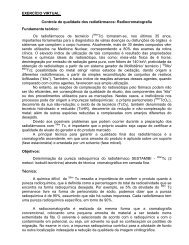Diagnóstico laboratorial das dermatofitoses
Diagnóstico laboratorial das dermatofitoses
Diagnóstico laboratorial das dermatofitoses
You also want an ePaper? Increase the reach of your titles
YUMPU automatically turns print PDFs into web optimized ePapers that Google loves.
PCR-RFLP (Polymerase Chain Reaction - Restriction<br />
Fragment Lengthy Polymorphism), no qual fragmentos<br />
de DNA do dermatófito, contidos material de lesão,<br />
foram extraídos, amplificados e posteriormente digeridos<br />
com enzimas de restrição. As amostras identifica<strong>das</strong><br />
desta forma apresentaram uma correspondência<br />
de 98,7% com o método padrão de cultivo <strong>das</strong> amostras<br />
em ágar Sabouraud.<br />
Apesar de todos estes avanços e da intensa pesquisa<br />
que está sendo realizada neste campo, o diagnóstico<br />
baseado na detecção e identificação de DNA fúngico<br />
ainda não pode ser considerado uma metodologia<br />
recomendada para ser utilizada no dia a dia da rotina<br />
de diagnóstico <strong>das</strong> <strong>dermatofitoses</strong>, tendo em vista a<br />
inexistência até o momento de uma padronização para<br />
os diferentes ensaios genéticos, o alto custo dos reagentes<br />
utilizados, a infra-estrutura necessária para a<br />
realização destes testes e o treinamento do pessoal de<br />
laboratório.<br />
CONCLUSÕES<br />
O diagnóstico <strong>laboratorial</strong> <strong>das</strong> <strong>dermatofitoses</strong> ainda<br />
se baseia nos métodos tradicionais de exame microscópico<br />
direto do material clínico e no cultivo do<br />
fungo em ágar Sabouraud ou meios similares, que contenham<br />
inibidores. Para que se alcance a sensibilidade<br />
e especificidade espera<strong>das</strong> nestes métodos, é necessário<br />
que o profissional envolvido na rotina micológica<br />
tome os devidos cuidados na colheita, conservação<br />
e transporte do material clínico, já que influenciarão<br />
muito no resultado final do exame. Novas metodologias<br />
que vem sendo desenvolvi<strong>das</strong> para serem<br />
aplica<strong>das</strong> na identificação dos dermatófitos a partir do<br />
seu DNA contido no material clínico proveniente da<br />
lesão, ainda não atingiram adequada padronização e<br />
uma relação custo/benefício que justifiquem a sua utilização<br />
na rotina <strong>laboratorial</strong>.<br />
REFERÊNCIAS<br />
1. Ajello, L.; Georg, L. K. In vitro hair cultures for differentiating between atypical<br />
isolates of Trichophyton mentagrophytes and Trichophyton rubrum.<br />
Mycopathol. Mycol. Appl., 8:3-17, 1957.<br />
2. Baek, S. C.; Chae, H. J.; Houh, D.; Byun, D. G.; Cho, B. K. Detection and<br />
differentiation of causative fungi of onychomycosis using PCR amplification<br />
and restriction enzyme analysis. Int. J. Dermatol., 37:682-686, 1998.<br />
3. Bock, M.; Maiwald, M.; Kappe, R., Nickel, P.; Näher, H. Polymerase chain<br />
reaction-based detection of dermatophyte DNA with a fungus-specific primer<br />
system. Mycoses, 37:79-84, 1994.<br />
4. Borelli, D. Medios caseros para micologia. Arch. Venez. Med. Trop. y Parasitol.,<br />
4: 301-310, 1962.<br />
5. Clayton, Y. M.; Midgley, G. Identification of agents of superficial mycoses.<br />
In: Evans, E. G. V.; Richardson, M. D. Medical Mycology - a practical approach.<br />
IRL Press, Oxford, 1989.<br />
6. Davey, K. G.; Campbell, C. K.; Warnock, D. W. Mycological techniques. J.<br />
Clin. Pathol, 49:95-99, 1996.<br />
7. Elder, B. L.; Roberts, G. D. Rapid methods for the diagnosis of fungal infections.<br />
Lab. Med., 17: 591-596, 1986.<br />
8. Evans, E. G. V.; Richardson, M. D. General guidelines on laboratory diagnosis.<br />
In: Evans, E. G. V.; Richardson, M. D. Medical Mycology - a practical<br />
approach. IRL Press, Oxford, 1989.<br />
9. Fisher, J. B.; Kane, J. The laboratory diagnosis of dermatophytosis complicated<br />
by Candida albicans. Can. J. Microbiol., 20: 167-182, 1974.<br />
10. Gräser, Y.; Kuijpers, A. F. A.; Presber, W.; De Hoog, G. S. Molecular taxonomy<br />
of Trichophyton mentagrophytes and Trichophyton tonsurans. Med.<br />
Mycol., 37:315-330, 1999.<br />
11. Hageage, G. L.; Harrington, B. J. Use of calcoflúor white in clinical mycology.<br />
Lab. Med.15:109-112, 1984.<br />
12. Haldane, D. J. M.; Robart, E. A comparison of calcofluor white, potassium<br />
hydroxide, and culture for the laboratory diagnosis of superficial fungal infection.<br />
Diag. Microbiol. Infect. Dis., 13: 337-339, 1990.<br />
13. Harmsen, D.; Schwinn, A.; Brocker, E. B.; Frosch, M. Molecular differentiation<br />
of dermatophyte fungi. Mycoses 42:67-70, 1999.<br />
14. Kaminski, G. W. The routine use of modified Borelli’s Lactrimel agar (MBLA).<br />
Mycopathology, 91:57-59, 1985.<br />
15. Kano, R.; Nakamura, Y.;, Watanabe, S.; Tsujimoto, H.; Hasegawa, A. Phylogenetic<br />
relation of Epidermophyton floccosum to the species of Microsporum<br />
and Trichophyton in chitin synthase 1 (CHS1) gene sequences. Mycopathology,<br />
146:111-113, 1999.<br />
16. Kano, R.; Okabayashi, K.; Nakamura, Y.; Ooka, S.; Kashima, M.; Mizoguchi,<br />
M.; Watanabe, S.; Hasegawa, A. Differences among chitin synthase<br />
I gene sequences in Trichophyton rubrum and T. violaceum. Med. Mycol.<br />
38:47-50, 2000.<br />
17. Lacaz, C. S.; Porto, E.; Martins, J. E. C. Micologia Médica. Sarvier, 8ª ed.,<br />
São Paulo, 1991.<br />
18. Leclerc, M. C.; Philippe, H.; Guého, E. Phylogeny of dermatophytes and<br />
dimorphic fungi based on large subunit ribosomal RNA sequence comparisons.<br />
J. Med. Vet. Mycol., 32:331-341, 1994.<br />
19. Liu, D.; Coloe, S.; Baird, R.; Pedersen, J. Molecular determination of dermatophyte<br />
fungi using the arbitrarily primed polymerase chain reaction. B.<br />
J. Dermatol., 137:351-355, 1997.<br />
20. Liu, D.; Coloe, S.; Baird, R.; Pedersen, J. Application of PCR to the identification<br />
of dermatophyte fungi. J. Med. Microbiol., 49:493-497, 2000.<br />
21. Machouart-Dubach, M.; Lacroix, C.; De Chauvin, F. M.; Le Gall, L.; Giudicelli,<br />
C.; Lorenzo, F.; Derouin, F. Rapid discrimination among dermatophytes,<br />
Scytalidium spp, and other fungi with a PCR-restriction fragment<br />
length polymorphism ribotyping method. J. Clin. Microbiol., 39:685-690, 2001.<br />
22. Makimura, K.; Tamura, Y.; Mochizuki, T.; Hasegawa, A.; Tajiri, Y.; Hanazawa,<br />
R.; Uchida, K.; Saito, H.; Yamaguchi, H. Phylogenetic classification<br />
and species identification of dermatophyte strains based on DNA sequences<br />
of nuclear ribosomal internal transcribed spacer 1 regions. J. Clin. Microbiol.,<br />
37:920-924, 1999.<br />
23. Milne, L. J. R. Direct microscopy. In: Evans, E. G. V.; Richardson, M. D.<br />
Medical Mycology - a practical approach. IRL Press, Oxford, 1989.<br />
24. Mochizuki, T.; Kawasaki, M.; Ishizaki, H.; Makimura, K. Identification of<br />
several clinical isolates of dermatophytes based on the nucleotide sequence<br />
of internal transcribed spacer 1 (ITS 1) in nuclear ribosomal DNA.<br />
J. Dermatol. 26:276-81, 1999.<br />
25. Monheit, J. E.; Brown, G.; Kott, M. M.; Schmidt, W. A.; Moore, D. G. Calcofluor<br />
white detection of fungi in cytopathology. Am. J. Clin. Pathol.,<br />
108:616-618, 1986.<br />
26. Monheit, J. E.; Cowan, D. F.; Moore, D. G. Rapid detection of fungi in tissues<br />
using calcofluor white and fluorescence microscopy. Arch. Pathol. Lab.<br />
Med., 108:616-618, 1984.<br />
27. Moriello, K. A.; Deboer, D. J. Fungal flora of the haircoat of cats with and<br />
without dermatophytosis. J. Med. Vet. Mycol., 29:219-230, 1991.<br />
28. Philpot, C. The differentiation of Trichophyton mentagrophytes from Trichophyton<br />
rubrum by a single urease test. Sabouraudia, 5:189-193, 1967.<br />
29. Richardson, M. D.; Evans. Culture and isolation of fungi. In: Evans, E. G.V.;<br />
Richardson, M. D. Medical Mycology - a practical approach. IRL Press,<br />
Oxford, 1989.<br />
30. Rippon, J. W. Medical mycology: the pathogenic fungi and the pathogenic<br />
actomycetes. WB Saunders, 3 rd , Philadelphia,1988.<br />
31. Shadowy, H. J.; Philpot, C. M. Utilization of standard laboratory methods in<br />
the laboratory diagnosis of problem dermatophytes. Am. J. Clin. Pathol.,<br />
74:197-201, 1980.<br />
32. Summerbell, R. C.; Haugland, R. A.; Li, A.; Gupta, A. K. rRNA gene internal<br />
transcribed spacer 1 and 2 sequences of asexual, anthropophilic dermatophytes<br />
related to Trichophyton rubrum. J. Clin. Microbiol., 37:4005-4011, 1999.<br />
33. Taplin, D.; Zaias, N.; Rebell, G.; Blank, H. Isolation and recognition of dermatophytes<br />
on a new medium (DTM). Arch. Dermatol., 99:203-209, 1969.<br />
34. Turin, L.; Riva, F.; Galbiati, G.; Cainelli, T. Fast, simple and highly sensitive<br />
double-rounded polymerase chain reaction assay to detect medically relevant<br />
fungi in dermatological specimens. Eur. J. Clin. Invest., 30:511-518, 2000.<br />
Endereço para correspondência:<br />
Prof. Jairo Ivo dos Santos<br />
Departamento de Análises Clínicas, Centro de Ciências da Saúde - UFSC<br />
Campus Universitário, Florianópolis, SC - 88040-970<br />
Tel.: (0xx48) 331-9712<br />
E-mail: jivo@cc.ufsc.br<br />
6 RBAC, vol. 34(1), 2002




